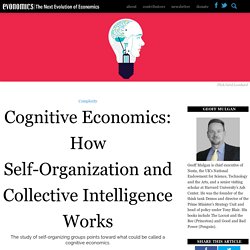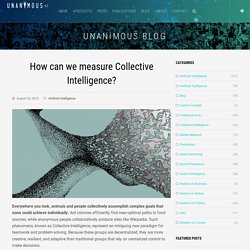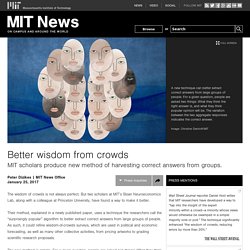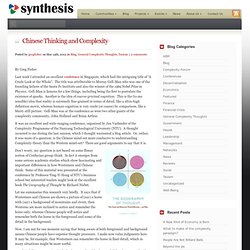

The Two Traits of the Best Problem-Solving Teams. Executive Summary An analysis of 150 senior teams showed that the ones who solve problems the fastest tend to be cognitively diverse. But this isn’t always true — sometimes, those teams still struggle. So what separates the best teams from the rest? It turns out that it’s a combination of cognitive diversity and psychological safety. Teams high in both traits show curious and encouraging behavior, and also the level of forcefulness and experimentation needed to keep their momentum. Imagine you are a fly on the wall in a corporate training center where a management team of 12 is participating in a session on executing strategy. What happened?
In an earlier article, “Teams Solve Problems Faster When They’re More Cognitively Diverse,” we reported our research findings that teams with high levels of cognitive diversity performed better on these kinds of challenges. Cognitive Economics: How Self-Organization and Collective Intelligence Works. By Geoff Mulgan The organization of thought as a series of nested loops, each encompassing the others, is a general phenomenon.

You Do Not Think Alone. “The Thinker,” Auguste Rodin’s bronze sculpture, has become a visual cliché, a common representation of deep thought — a figure, gazing down, chin on hand, completely alone.

This is utterly misleading, according to the authors of “The Knowledge Illusion,” which carries the subtitle: “Why We Never Think Alone.” Steven Sloman, a professor at Brown University, and Philip Fernbach, a professor at the University of Colorado’s Leeds School of Business, argue that our intelligence depends on the people and things that surround us, and to a degree we rarely recognize. Knowledge, they say, is a community effort. Sloman answered questions from Mind Matters editor Gareth Cook. Groupthink Can Actually Be Good, If It’s Done Right. The wisdom of crowds has been taking a battering lately.

Last November, every major news outlet and pollster said Donald Trump would lose the presidential election, and just last week there was similarly unanimous consensus that Britain’s Conservative Party was headed to a big win in its own election. How can we measure Collective Intelligence? - UNANIMOUS A.I.UNANIMOUS A.I. Everywhere you look, animals and people collectively accomplish complex goals that none could achieve individually.

Ant colonies efficiently find near-optimal paths to food sources, while anonymous people collaboratively produce sites like Wikipedia. Such phenomena, known as Collective Intelligence, represent an intriguing new paradigm for teamwork and problem-solving. Because these groups are decentralized, they are more creative, resilient, and adaptive than traditional groups that rely on centralized control to make decisions. I study collective intelligence across multiple domains — from termites constructing mounds to people solving problems over the Internet. Yet while these topics are unified under the domain of collective intelligence, we have no unified way to study them. I have recently been thinking of ways we can define, identify, and measure collective intelligence in a domain-independent manner. 1) The collective outperforms individuals on the given task.
Cookies are Not Accepted - New York Times. Better wisdom from crowds. The wisdom of crowds is not always perfect.

But two scholars at MIT’s Sloan Neuroeconomics Lab, along with a colleague at Princeton University, have found a way to make it better. Their method, explained in a newly published paper, uses a technique the researchers call the “surprisingly popular” algorithm to better extract correct answers from large groups of people. As such, it could refine wisdom-of-crowds surveys, which are used in political and economic forecasting, as well as many other collective activities, from pricing artworks to grading scientific research proposals. The new method is simple. For a given question, people are asked two things: What they think the right answer is, and what they think popular opinion will be. The paper is built on both theoretical and empirical work. The paper, “A solution to the single-question crowd wisdom problem,” is being published today in Nature.
A capital idea That means the answer to the two questions — Is Philadelphia the capital? Teams Solve Problems Faster When They’re More Cognitively Diverse. Looking at the executive teams we work with as consultants and those we teach in the classroom, increased diversity of gender, ethnicity, and age is apparent.

Over recent decades the rightful endeavor to achieve a more representative workforce has had an impact. Of course, there is a ways to go, but progress has been made. Throughout this period, we have run a strategic execution exercise with executive groups focused on managing new, uncertain, and complex situations. Eight Dangers of Collaboration. Most of what is written about collaboration is positive.

Even hip. Collaboration is championed enthusiastically by the Enterprise 2.0 experts, as well as leading thinkers like Don Tapscott, as the crucial approach for the 21st century. Collaboration creates once-elusive “buy-in or “empowerment,” improves problem solving, increases creativity, is key to innovation at companies like Lego, Pixar, and Intuit. Collective IQ Keen On… David Weinberger: Too Big To Know (TCTV) Chinese Thinking and Complexity. By Greg Fisher Last week I attended an excellent conference in Singapore, which had the intriguing title of “A Crude Look at the Whole”.

The title was attributable to Murray Gell-Man who was one of the founding fathers of the Santa Fe Institute and also the winner of the 1969 Nobel Prize in Physics. The Emergence of Collective Intelligence. MIT Unravels the Secrets Behind Collective Intelligence – Hint: IQ Not So Important. What makes a group able to succeed at large number of different tasks?

Women, sharing, and sensitivity. When it comes to a successful group, the easiest way to ensure victory may be placing women on the team. MIT’s Center for Collective Intelligence seeks to understand how humans get better (or worse) at solving problems as they work together. Forget the Wisdom of Crowds; Neurobiologists Reveal the Wisdom of the Confident. COLLECTIVE INTELLIGENCE. It's also possible for groups of people to work together in ways that seem pretty stupid, and I think collective stupidity is just as possible as collective intelligence.

How to Make Better Decisions Together. Learning how to make decisions together is a crucial element of getting along and getting things done with others. It’s wise for your group to learn how to steer your boat together with collective decision-making before you have a sinking ship on your hands. I’ve learned these skills through workshops, readings and from living and working in cooperatives and they have been incredibly valuable to the success of these projects.
Collective decision-making has innumerable rewards. If group members affected by the decision are involved, less conflict will result. If folks implementing the decision are involved, decisions are more likely to be implemented with hard work and enthusiasm, and empowered decision-makers are likely to stick around for the long haul. A strong example of collective decision-making is participatory budgeting which often leads to less contentious, more inclusive budgetary decisions – not an easy challenge. Consensus flowchart by Grant Horwood Group Mind. Making Dumb Groups Smarter - HBR. Collective Action Toolkit. Is it possible to inspire design thinking outside of the design world? Loomio. The Power of Talk: Who Gets Heard and Why. The head of a large division of a multinational corporation was running a meeting devoted to performance assessment.
How to Explain Mansplaining. Photo.